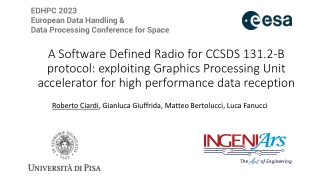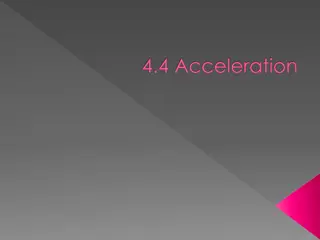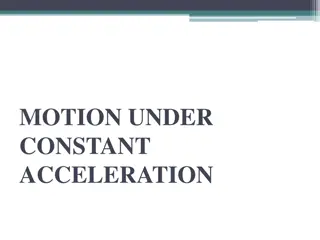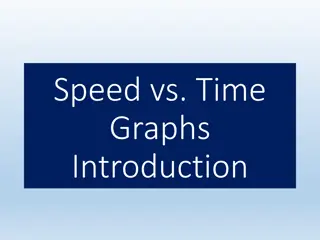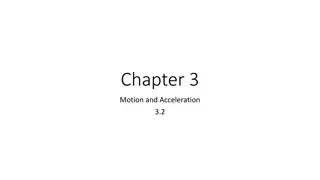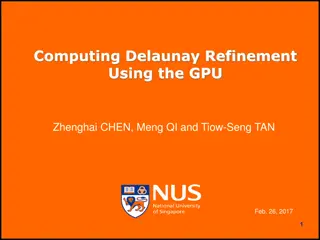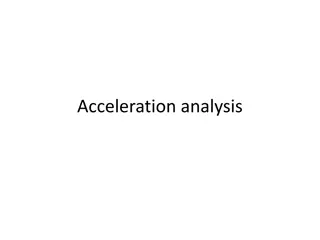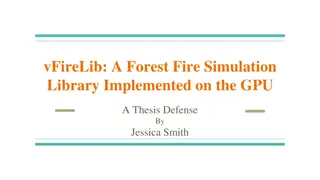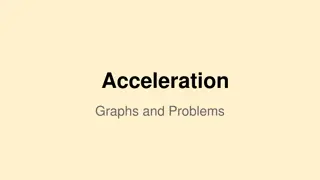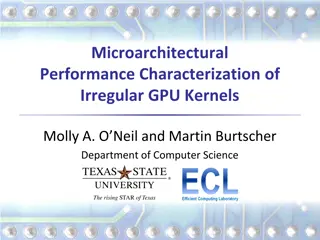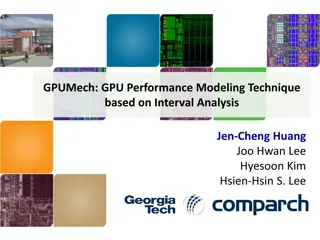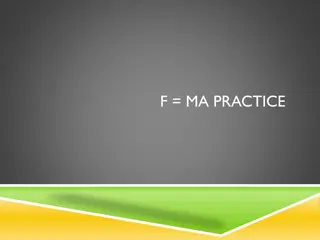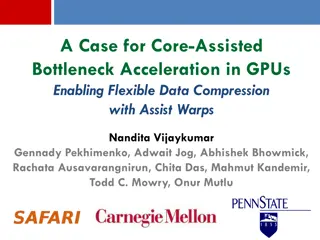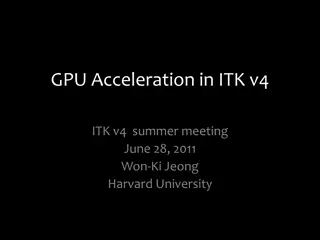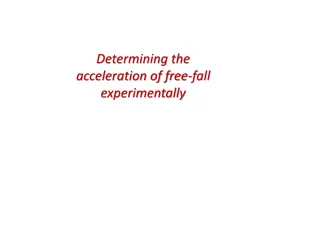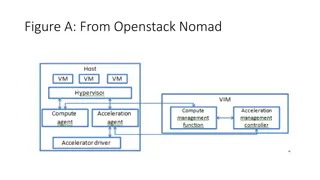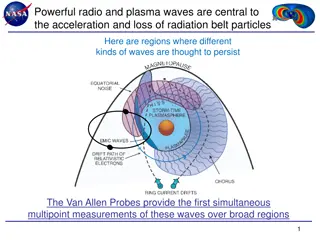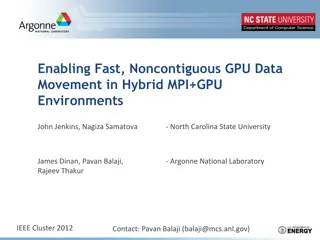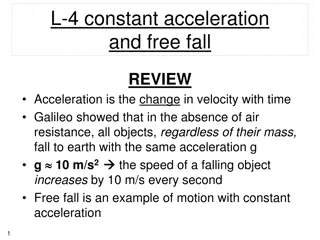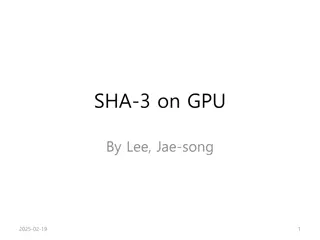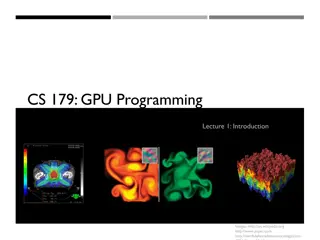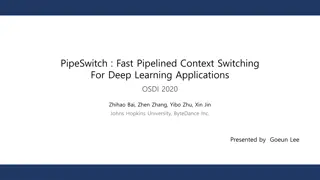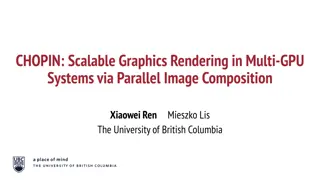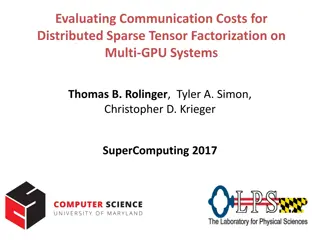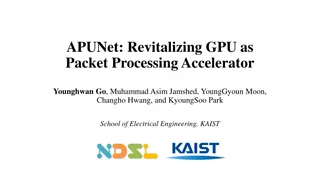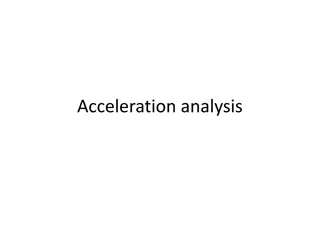Enhancing Data Reception Performance with GPU Acceleration in CCSDS 131.2-B Protocol
Explore the utilization of Graphics Processing Unit (GPU) accelerators for high-performance data reception in a Software Defined Radio (SDR) system following the CCSDS 131.2-B protocol. The research, presented at the EDHPC 2023 Conference, focuses on implementing a state-of-the-art GP-GPU receiver t
9 views • 33 slides
Acceleration in Physics
Acceleration is the rate at which velocity changes, encompassing both increases and decreases in speed. In physics, acceleration is defined as the rate of change in velocity, making it a vector quantity due to its directional nature. This article explores the concept of acceleration, including examp
2 views • 15 slides
Motion Under Constant Acceleration
Constant acceleration refers to motion where the speed increases by the same amount each second. It is exemplified in scenarios like free fall due to gravity, where objects experience a consistent acceleration of approximately 10 meters per second squared. This type of motion plays a significant rol
5 views • 11 slides
Speed vs. Time Graphs: Analyzing Acceleration and Motion
Explore the concept of speed vs. time graphs and learn how to recognize acceleration, interpret speed, analyze motion, and calculate acceleration from the slope of the graph. Discover the characteristics of graphs showing constant acceleration, varying acceleration, and deceleration. Engage in drawi
3 views • 19 slides
Acceleration in Motion: Concepts and Examples
Delve into the world of acceleration in motion with this informative content. Learn how acceleration is defined, its relationship with velocity, and the different types of acceleration - positive, negative, and zero. Examples like a car at a stoplight, a bouncing ball, and a jet airliner on a runway
4 views • 8 slides
GPU-Accelerated Delaunay Refinement: Efficient Triangulation Algorithm
This study presents a novel approach for computing Delaunay refinement using GPU acceleration. The algorithm aims to generate a constrained Delaunay triangulation from a planar straight line graph efficiently, with improvements in termination handling and Steiner point management. By leveraging GPU
21 views • 23 slides
Acceleration Analysis of Slider Crank Mechanism
In this analysis, we calculate the acceleration of the slider at point B, acceleration of point E, and the angular acceleration of the link AB in a slider crank mechanism. The steps involve drawing configuration, velocity, and acceleration diagrams with suitable scales to determine the necessary par
6 views • 12 slides
vFireLib: Forest Fire Simulation Library on GPU
Dive into Jessica Smith's thesis defense on vFireLib, a forest fire simulation library implemented on the GPU. The research focuses on real-time GPU-based wildfire simulation for effective and safe wildfire suppression efforts, aiming to reduce costs and mitigate loss of habitat, property, and life.
3 views • 95 slides
Acceleration in Physics
Explore the concept of acceleration through real-world scenarios involving moving objects and graphs. Learn how to determine the direction of acceleration based on the velocity changes of cars, divers, bungee jumpers, and more. Delve into examples of calculating average acceleration and final veloci
1 views • 11 slides
Microarchitectural Performance Characterization of Irregular GPU Kernels
GPUs are widely used for high-performance computing, but irregular algorithms pose challenges for parallelization. This study delves into the microarchitectural aspects affecting GPU performance, emphasizing best practices to optimize irregular GPU kernels. The impact of branch divergence, memory co
3 views • 26 slides
Advanced GPU Performance Modeling Techniques
Explore cutting-edge techniques in GPU performance modeling, including interval analysis, resource contention identification, detailed timing simulation, and balancing accuracy with efficiency. Learn how to leverage both functional simulation and analytical modeling to pinpoint performance bottlenec
1 views • 32 slides
Effect of Weighted Sled Towing and Weighted Vest on Sprinter Acceleration Performance
Short distance running involves crucial phases affecting sprint performance, with acceleration being particularly important. Training methods like weighted sled towing and weighted vest usage have been found effective in enhancing sprint acceleration. This study investigated the impact of these meth
5 views • 8 slides
Mechanics Practice Problems with Force and Acceleration
Solve practice problems involving force, mass, and acceleration in physics. Calculate net force accelerating a bicycle, mass of the Space Shuttle based on thrust and acceleration, acceleration of a runner given force and mass, and acceleration of a car with a known force and mass.
4 views • 5 slides
Core-Assisted Bottleneck Acceleration in GPUs: Maximizing Resource Utilization
Imbalances in GPU execution lead to underutilization of resources, prompting the need for a solution like CABA (Core-Assisted Bottleneck Acceleration). This framework enables the efficient use of helper threads in GPUs, addressing memory bandwidth bottlenecks through flexible data compression. By le
2 views • 37 slides
Communication Costs in Distributed Sparse Tensor Factorization on Multi-GPU Systems
This research paper presented an evaluation of communication costs for distributed sparse tensor factorization on multi-GPU systems. It discussed the background of tensors, tensor factorization methods like CP-ALS, and communication requirements in RefacTo. The motivation highlighted the dominance o
4 views • 34 slides
GPU Acceleration in ITK v4 Overview
This presentation by Won-Ki Jeong from Harvard University at the ITK v4 winter meeting in 2011 discusses the implementation and advantages of GPU acceleration in ITK v4. Topics covered include the use of GPUs as co-processors for massively parallel processing, memory and process management, new GPU
5 views • 33 slides
GPU Computing and Synchronization Techniques
Synchronization in GPU computing is crucial for managing shared resources and coordinating parallel tasks efficiently. Techniques such as __syncthreads() and atomic instructions help ensure data integrity and avoid race conditions in parallel algorithms. Examples requiring synchronization include Pa
4 views • 22 slides
GPU Acceleration in ITK v4: Overview and Implementation
This presentation discusses the implementation of GPU acceleration in ITK v4, focusing on providing a high-level GPU abstraction, transparent resource management, code development status, and GPU core classes. Goals include speeding up certain types of problems and managing memory effectively.
3 views • 32 slides
Experimental Determination of Acceleration of Free Fall
Experimentally determining the acceleration of free fall by analyzing the motion of an apple and a feather falling in a vacuum. By scaling and analyzing the data, the acceleration is calculated to be approximately 9.82 m/s^2, indicating a constant acceleration due to gravity.
3 views • 13 slides
Acceleration Management Architectures in OpenStack Nomad and DPACC
The figures depict the architecture of Software Acceleration Layer (SAL), Acceleration Management Layer (AML), and other components in OpenStack Nomad and DPACC. They illustrate the interaction between Software Routing Layer (SRL), General Drivers (g-drivers), Hardware I/O Interface (hio), and more
6 views • 4 slides
Unveiling the Role of Radio and Plasma Waves in Particle Acceleration
Radio and plasma waves play a crucial role in the acceleration and loss of radiation belt particles. The Van Allen Probes provide groundbreaking multipoint measurements of these waves in various regions, shedding light on phenomena such as chorus waves and resonant wave acceleration. Strong correlat
4 views • 8 slides
Fast Noncontiguous GPU Data Movement in Hybrid MPI+GPU Environments
This research focuses on enabling efficient and fast noncontiguous data movement between GPUs in hybrid MPI+GPU environments. The study explores techniques such as MPI-derived data types to facilitate noncontiguous message passing and improve communication performance in GPU-accelerated systems. By
4 views • 18 slides
Constant Acceleration and Free Fall
Acceleration is the rate of change in velocity with time. In free fall, all objects fall to Earth with the same acceleration regardless of mass. This review covers motion with constant acceleration, including examples and explanations of velocity changes and simple cases with zero acceleration.
4 views • 21 slides
Implementing SHA-3 Hash Submissions on NVIDIA GPU
This work explores implementing SHA-3 hash submissions on NVIDIA GPU using the CUDA framework. Learn about the benefits of utilizing GPU for parallel tasks, the CUDA framework, CUDA programming steps, example CPU and GPU codes, challenges in GPU debugging, design considerations, and previous works o
3 views • 26 slides
GPU Programming Lecture: Introduction and Course Details
This content provides information about a GPU programming lecture series covering topics like parallelization in C++, CUDA computing platform, course requirements, homework guidelines, project details, and machine access for practical application. It includes details on TA contacts, class schedules,
1 views • 24 slides
PipeSwitch: Fast Pipelined Context Switching for DL Applications
PipeSwitch is a solution presented in OSDI 2020, aiming to enable GPU-efficient multiplexing of deep learning applications with fine-grained time-sharing. It focuses on achieving millisecond-scale context switching latencies and high throughput by optimizing GPU memory allocation and model transmiss
2 views • 26 slides
GPU Programming Primitives for Computer Graphics
This book covers advanced topics in GPU programming for computer graphics, including parallel reduction, prefix scan, programming primitives, linear probing, radix sort, and code optimization. It delves into the motivation behind leveraging thousands of threads on GPUs and addresses various challeng
3 views • 85 slides
GPU Architecture Research Beyond Assigned Readings
Dive into advanced GPU architecture research topics including mitigating SIMT control divergence, performance vs. warp size in applications, dynamic warp formation, and hardware implementations. Explore how innovations such as virtualized deep neural networks and multi-chip module GPUs are transform
4 views • 58 slides
Gem5-GPU Installation Guide for Advanced Computer Architecture
This comprehensive guide provides step-by-step instructions on setting up the Gem5-GPU environment on Ubuntu 14.04 LTS 64-bit platform. It covers essential packages installations, CUDA toolkit setup, gem5 and GPGPU-Sim cloning, and building the gem5-gpu code. By following these instructions, users c
2 views • 14 slides
Optimizing Multi-GPU Graphics Rendering Through Parallel Image Composition
Explore how CHOPIN enhances graphics rendering in multi-GPU systems by leveraging parallel image composition to eliminate bottlenecks and improve performance by up to 56%. Understand the significance of inter-GPU synchronization in generating high-quality images and overcoming limitations such as re
3 views • 19 slides
Communication Costs for Distributed Sparse Tensor Factorization on Multi-GPU Systems
Evaluate communication costs for distributed sparse tensor factorization on multi-GPU systems in the context of Supercomputing 2017. The research delves into background, motivation, experiments, results, discussions, conclusions, and future work, emphasizing factors like tensors, CP-ALS, MTTKRP, and
5 views • 34 slides
Acceleration in Motion Studies
Learn about acceleration in motion studies - the rate at which velocity changes with time, the impact of speed and direction changes, calculations of average acceleration, and the relationship between velocity and acceleration. Explore constant acceleration equations and analyze position-time graphs
4 views • 13 slides
GPU Programming Lecture 7: Memory Optimizations and GPU Reductions
This lecture delves into memory optimizations using different GPU caches, atomic operations, synchronization techniques, and advanced GPU-accelerated algorithms such as reductions for parallelizing non-intuitively parallelizable problems. Explore reductions for GPUs, properties of reduction operator
3 views • 45 slides
Revitalizing GPU for Packet Processing Acceleration
Explore the potential of GPU-accelerated networked systems for executing parallel packet operations with high power and bandwidth efficiency. Discover how GPU benefits from memory access latency hiding and compare CPU vs. GPU memory access hiding. Uncover the contributions of GPUs in packet processi
4 views • 22 slides
Managing GPU Concurrency in Heterogeneous Architectures
This study delves into managing GPU concurrency in heterogeneous architectures, delving into LLC memory, network, and shared resources, improving GPU and CPU performance through warp scheduler controls, CPU-centric and CPU-GPU balanced strategies. Results show positive impacts on CPU performance whi
1 views • 16 slides
Velocity and Acceleration Analysis of Four-Bar Chain Mechanism
Explore the velocity and acceleration diagrams of a four-bar chain mechanism with detailed step-by-step analysis. Learn about angular velocity, angular acceleration, radial acceleration, and tangential acceleration of the chain links.
0 views • 8 slides
Understanding CUDA Programming for GPU Acceleration
Explore the world of GPU programming with CUDA, NVIDIA's parallel computing model. Learn about heterogeneous programming, CUDA kernels, memory management, and the basic structure of CUDA programs. Dive into allocating memory in the GPU and host, and discover the fork-join model for parallel processi
2 views • 14 slides
Understanding GPU Architecture and CUDA Development
Explore the fundamentals of GPU architecture, CUDA setup, and development without a PhD. Learn about the advantages of massively parallel processing and how to leverage GPU memory for efficient data processing. Dive into the world of GPU-based applications and see immediate benefits without extensiv
1 views • 34 slides
Accelerated Image Processing with GPU Technology
Efficiently process large pathology images using GPU acceleration. Utilize CUDA functions for memory-efficient batch-wise processing and integration with Python for orchestration. Explore the pipeline overview and GPU acceleration techniques in detail. Get insights into the dataset statistics and th
5 views • 12 slides
Uniform Acceleration Equations Derivation
Explore the derivation of uniform acceleration equations in physics, including velocity, displacement, and acceleration calculations. Understand the integration process and how vectors play a role in determining velocity and acceleration. Dive into the fundamental concepts of motion and how calculus
1 views • 47 slides
